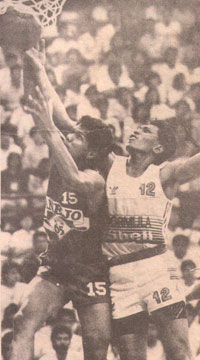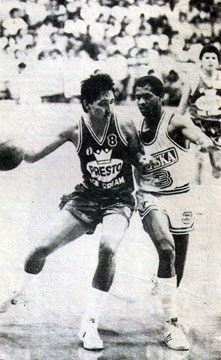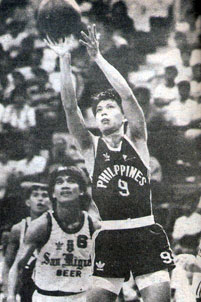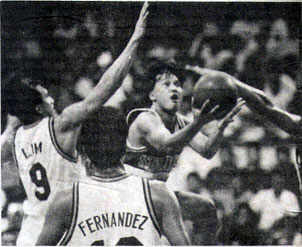Filtered By: Sports
Sports
PBA Top Rookie Picks: The good, the bad and the outstanding
By Rey Joble, GMANews.TV
First of three parts Nonoy Baclao has just made the elite list of players to be picked No. 1 in the Philippine Basketball Association (PBA) Rookie Draft. But will the do-it-all forward from Ateneo live up to his billing? Or will he become like some top rookies who wound up as mere footnotes? GMANews.TV looked back at the PBA's top overall rookie picks through the years. Since the Rookie Draft was implemented in 1985, some of these players made their mark in the pro league, while others turned out to be lemons. Here are the PBA's top overall rookie picks through the years. Sonny Cabatu (1985) –A lot of people will remember this bemoustached lefty player who once missed two free throws with no time left, thus costing Great Taste a game against San Miguel Beer in 1988. There were a lot of expectations when he entered the league in 1985. He was a two-time Most Valuable Player (MVP) in the old Philippine Amateur Basketball League (PABL) and was expected to provide muscle to a young Shell Azodrin Bug Busters squad composed of players from the fabled Crispa Redmanizers like Bogs Adornado, Bernie Fabiosa, Philip Cezar and Bai Cristobal. Being one of the tallest players on the squad, Cabatu was quickly installed as the starting center. But he was definitely overshadowed by his smaller yet more skillful teammate, Leo Austria, who eventually won the Rookie of the Year (ROY) award. Throughout his career, the 6-foot-5 slotman would play the role of an enforcer rather than a typical go-to-guy normally seen among top overall picks. Rey Cuenco (1986) – The late Rey Cuenco entered the pro league with an impressive resume: a member of the 1982 RP Youth champion squad where he served as backup center to the late Teddy Alfarero, and as part of the Masagana 99 champion squad in the PABL. The 6-foot-4 Cuenco was taken in by Alaska, then the newest team in the PBA, in 1986. Still, his transformation to become a dependable frontliner would take some time, and not before he was upstaged by another newcomer who would eventually become one of the most popular figures during the glory years of the PBA – Dondon Ampalayo of Ginebra, the eventual winner of the Rookie of the Year award. The biggest improvement in Cuenco's career happened in 1989 when he was traded by Shell to Añejo for the rights on Romy Dela Rosa. There, under the tutelage of the Living Legend, playing coach Robert Jaworski, Cuenco would enjoy superstar status and eventually become one of the best center/forwards in the league. Proof of that was his inclusion in the first all-pro national team that won a silver medal in the 1990 Beijing Asian Games. Allan Caidic (1987) – 'The Triggerman' was already the most feared outside shooter ever to come out from the amateur ranks when he joined Great Taste in 1987. Not only was he regarded as a deadly shooter after setting the record for most number of three-point shots (10 in the UAAP, August 1985) and piling up the second-highest points scored in a finals match (48 points, 1985). Players in the Asian region were alarmed every time they faced the man wearing jersey No. 8, beginning in the mid-1980s. The 6-foot-2 gunner from University of the East won the MVP award three times (1982, 1984, 1985) while spearheading the Warriors to back-to-back titles in the 1984-85 UAAP seasons. Caidic was a member of the Northern Consolidated Cement champion squad, the first guest team to win a title in the pro league. Then, in 1986, he helped the RP team to win the Asian Basketball Confederation crown (now known as FIBA Asia Championship) and the William Jones Cup title. As a pro, Caidic quickly made his presence felt. Caidic appeared in the finals of the first two conferences in his first season, which included Great Taste’s 1987 All-Filipino crown. He was adjudged as the Rookie of the Year that season. Three years later, he won the MVP award and another title for the Gokongwei franchise. In between those feats, Caidic would shatter the individual single-game scoring and three-point shots records either by a local player or import. In 1991, he scored 79 points while sinking 17 triples, a record that remains unbroken.
The 6-foot-4 Cuenco was taken in by Alaska, then the newest team in the PBA, in 1986. Still, his transformation to become a dependable frontliner would take some time, and not before he was upstaged by another newcomer who would eventually become one of the most popular figures during the glory years of the PBA – Dondon Ampalayo of Ginebra, the eventual winner of the Rookie of the Year award. The biggest improvement in Cuenco's career happened in 1989 when he was traded by Shell to Añejo for the rights on Romy Dela Rosa. There, under the tutelage of the Living Legend, playing coach Robert Jaworski, Cuenco would enjoy superstar status and eventually become one of the best center/forwards in the league. Proof of that was his inclusion in the first all-pro national team that won a silver medal in the 1990 Beijing Asian Games. Allan Caidic (1987) – 'The Triggerman' was already the most feared outside shooter ever to come out from the amateur ranks when he joined Great Taste in 1987. Not only was he regarded as a deadly shooter after setting the record for most number of three-point shots (10 in the UAAP, August 1985) and piling up the second-highest points scored in a finals match (48 points, 1985). Players in the Asian region were alarmed every time they faced the man wearing jersey No. 8, beginning in the mid-1980s. The 6-foot-2 gunner from University of the East won the MVP award three times (1982, 1984, 1985) while spearheading the Warriors to back-to-back titles in the 1984-85 UAAP seasons. Caidic was a member of the Northern Consolidated Cement champion squad, the first guest team to win a title in the pro league. Then, in 1986, he helped the RP team to win the Asian Basketball Confederation crown (now known as FIBA Asia Championship) and the William Jones Cup title. As a pro, Caidic quickly made his presence felt. Caidic appeared in the finals of the first two conferences in his first season, which included Great Taste’s 1987 All-Filipino crown. He was adjudged as the Rookie of the Year that season. Three years later, he won the MVP award and another title for the Gokongwei franchise. In between those feats, Caidic would shatter the individual single-game scoring and three-point shots records either by a local player or import. In 1991, he scored 79 points while sinking 17 triples, a record that remains unbroken.  After playing for Great Taste for six seasons, Caidic found himself reunited with old buddies, Samboy Lim, Hector Calma and other former members of the NCC squad with the San Miguel Beermen. He joined the Beermen in 1993 and won a title there in the Third Conference of that same season and the 1994 All-Filipino. In 1994 and 1998, Caidic joined the all-pro RP teams to the Asian Games. He would end up his playing career in the PBA as a playing assistant coach for Ginebra in 1999, before becoming head coach of the most popular team in the land the following year. He was also named as one of the league's 25 Greatest Players. Jack Tanuan (1988) – A lot of people still think it was Jojo Lastimosa, the eventual ROY, Alvin Patrimonio or Jerry Codiñera — three illustrious teammates — who was the top overall pick in 1988. Only a few remember that it was Tanuan, easily the quietest man in the star-studded Purefoods Hotdogs squad, who was drafted No. 1. Lastimosa, Codiñera, Patrimonio and Glen Capacio were direct hires from the amateur ranks as part of the special concession for Purefoods, then the newest member in the PBA. The team also absorbed some of the members of the old Tanduay franchise, such as Mon Fernandez, Freddie Hubalde, Willie Generelao and JB Yango. Of course, Tanuan had to play in the shadows of Fernandez and Codiñera, and struggled in his first season. As expected, Lastimosa and Patrimonio contended for the ROY award, with the former winning the plum because of more games played. As for Tanuan, he blossomed when 'The Maestro' Baby Dalupan took over the coaching reins for the Hotdogs. In 1991, Tanuan, along with another ex-Purefoods player, Al Solis, were lured by Swift to become the team's new franchise players. The 6-foot-6 former Far Eastern University stalwart became a journeyman the next few years, and would win his last PBA championship with the Alaska Aces in the 1997 Governors Cup. Tanuan strutted his wares in the now defunct Metropolitan Basketball Association in 1998, playing for the Negros Slashers. He died in 2002 at the age of 36. Benjie Paras (1989) – A young player from University of the Philippines emerged with two great assets for players in the center position – power and intensity.
After playing for Great Taste for six seasons, Caidic found himself reunited with old buddies, Samboy Lim, Hector Calma and other former members of the NCC squad with the San Miguel Beermen. He joined the Beermen in 1993 and won a title there in the Third Conference of that same season and the 1994 All-Filipino. In 1994 and 1998, Caidic joined the all-pro RP teams to the Asian Games. He would end up his playing career in the PBA as a playing assistant coach for Ginebra in 1999, before becoming head coach of the most popular team in the land the following year. He was also named as one of the league's 25 Greatest Players. Jack Tanuan (1988) – A lot of people still think it was Jojo Lastimosa, the eventual ROY, Alvin Patrimonio or Jerry Codiñera — three illustrious teammates — who was the top overall pick in 1988. Only a few remember that it was Tanuan, easily the quietest man in the star-studded Purefoods Hotdogs squad, who was drafted No. 1. Lastimosa, Codiñera, Patrimonio and Glen Capacio were direct hires from the amateur ranks as part of the special concession for Purefoods, then the newest member in the PBA. The team also absorbed some of the members of the old Tanduay franchise, such as Mon Fernandez, Freddie Hubalde, Willie Generelao and JB Yango. Of course, Tanuan had to play in the shadows of Fernandez and Codiñera, and struggled in his first season. As expected, Lastimosa and Patrimonio contended for the ROY award, with the former winning the plum because of more games played. As for Tanuan, he blossomed when 'The Maestro' Baby Dalupan took over the coaching reins for the Hotdogs. In 1991, Tanuan, along with another ex-Purefoods player, Al Solis, were lured by Swift to become the team's new franchise players. The 6-foot-6 former Far Eastern University stalwart became a journeyman the next few years, and would win his last PBA championship with the Alaska Aces in the 1997 Governors Cup. Tanuan strutted his wares in the now defunct Metropolitan Basketball Association in 1998, playing for the Negros Slashers. He died in 2002 at the age of 36. Benjie Paras (1989) – A young player from University of the Philippines emerged with two great assets for players in the center position – power and intensity.  That's Benjie Paras, the top overall rookie pick of Class 1989, a batch that is still considered as having had the richest pool of newcomers ever. Nelson Asaytono, Bong Alvarez, Dindo Pumaren, Elmer Cabahug, Ato Agustin and Bobby Jose were some of the many talented players who entered the pro league that year. But Paras was a cut above the rest. Quickly, he imposed his will and powered Shell to a finals stint in his first season. By the end of the season, Paras was acknowledged as the first player in the PBA to win both the MVP and ROY awards. Paras would serve as the other half of Shell's successive campaigns. Together with Ronnie Magsanoc, Paras would win three championships with the Turbochargers and cap his brilliant career with another MVP award in 1999 to join an elite list of players to win the award at least two times. A member of the all-pro RP team in the 1990 Asian Games, Paras was also selected as one of the PBA's 25 Greatest Players. Peter Jao (1990) – After an invasion of superstars for three consecutive years, the PBA welcomed the new decade with a lean crop of talents. Peter 'Apet' Jao was tapped by Presto to become the heir apparent to Caidic. But Caidic's shoes were too big to fill, and the pressure was clearly felt by Jao in his rookie year. Jao was clearly overshadowed by his teammate Gerry Esplana, who would win the ROY award. But the two players were fortunate to be part of Presto's last championship squad in the PBA before the franchise was acquired by Sta. Lucia Realty.
That's Benjie Paras, the top overall rookie pick of Class 1989, a batch that is still considered as having had the richest pool of newcomers ever. Nelson Asaytono, Bong Alvarez, Dindo Pumaren, Elmer Cabahug, Ato Agustin and Bobby Jose were some of the many talented players who entered the pro league that year. But Paras was a cut above the rest. Quickly, he imposed his will and powered Shell to a finals stint in his first season. By the end of the season, Paras was acknowledged as the first player in the PBA to win both the MVP and ROY awards. Paras would serve as the other half of Shell's successive campaigns. Together with Ronnie Magsanoc, Paras would win three championships with the Turbochargers and cap his brilliant career with another MVP award in 1999 to join an elite list of players to win the award at least two times. A member of the all-pro RP team in the 1990 Asian Games, Paras was also selected as one of the PBA's 25 Greatest Players. Peter Jao (1990) – After an invasion of superstars for three consecutive years, the PBA welcomed the new decade with a lean crop of talents. Peter 'Apet' Jao was tapped by Presto to become the heir apparent to Caidic. But Caidic's shoes were too big to fill, and the pressure was clearly felt by Jao in his rookie year. Jao was clearly overshadowed by his teammate Gerry Esplana, who would win the ROY award. But the two players were fortunate to be part of Presto's last championship squad in the PBA before the franchise was acquired by Sta. Lucia Realty. "Jao was a former PABL MVP and was highly-touted as the next important shooting guard to come out of the amateur ranks. He was supposed to play alongside Caidic, but instead became a backup," says Jay P. Mercado, a well-known historian of MYPBA.com, a rich source of basketball information. "The fact that Esplana, a second-round draftee, won the ROY award over Jao was a clear indication that Apet did not live up to expectations," says Barry Pascua, a veteran sports columnist and analyst. Alex Araneta (1991) – It's not every day that a team can tap a 6-foot-7 center that is available in the Draft. Alex Araneta was the other half of Ateneo's twin towers in their back-to-back championships in 1987 and 1988. Danny Francisco, another 6-foot-7 player, was his frontcourt partner and appeared to be the more promising one. But a serious heart condition prevented Francisco from making the big jump to the PBA. But Araneta was overrated, according to PBA chief statistician Fidel Mangonon III. ""He (Araneta) was overrated by Tim Cone," says Mangonon. "Tim has over-hyped many other players in his early years as coach." Araneta was an athletic big guy, a big reason why Alaska tapped him as the top overall rookie pick in 1991. "He's a 6-foot-7, athletic big man. He was drafted ahead of Bong Hawkins and Eugene Quilban because of this quality. But I've never seen him play with such impact, which is the reason why Quilban won the award," says Mercado. Vergel Meneses (1992) – Unlike Jao, The Aerial Voyager, Vergel Meneses, didn't have much difficulty co-existing with Caidic when he was picked by Presto.
"Jao was a former PABL MVP and was highly-touted as the next important shooting guard to come out of the amateur ranks. He was supposed to play alongside Caidic, but instead became a backup," says Jay P. Mercado, a well-known historian of MYPBA.com, a rich source of basketball information. "The fact that Esplana, a second-round draftee, won the ROY award over Jao was a clear indication that Apet did not live up to expectations," says Barry Pascua, a veteran sports columnist and analyst. Alex Araneta (1991) – It's not every day that a team can tap a 6-foot-7 center that is available in the Draft. Alex Araneta was the other half of Ateneo's twin towers in their back-to-back championships in 1987 and 1988. Danny Francisco, another 6-foot-7 player, was his frontcourt partner and appeared to be the more promising one. But a serious heart condition prevented Francisco from making the big jump to the PBA. But Araneta was overrated, according to PBA chief statistician Fidel Mangonon III. ""He (Araneta) was overrated by Tim Cone," says Mangonon. "Tim has over-hyped many other players in his early years as coach." Araneta was an athletic big guy, a big reason why Alaska tapped him as the top overall rookie pick in 1991. "He's a 6-foot-7, athletic big man. He was drafted ahead of Bong Hawkins and Eugene Quilban because of this quality. But I've never seen him play with such impact, which is the reason why Quilban won the award," says Mercado. Vergel Meneses (1992) – Unlike Jao, The Aerial Voyager, Vergel Meneses, didn't have much difficulty co-existing with Caidic when he was picked by Presto.  In the first place, Meneses was more of a slasher, an open-court player and a dunker. Second, the 6-foot-3 guard/forward complemented Caidic's game with his more all-around skills. In his early years, Meneses would dazzle the crowd with his acrobatic moves and rim-rattling slams. But there was more to Meneses' game than just gliding in mid-air and entertaining the crowd. In his third year as a pro, Meneses made his presence felt and quickly found a spot in Yeng Guiao's system with Swift. He would become the team’s cornerstone and win a championship from there. In 1995, under coach Derick Pumaren, he became the best player in the PBA and was named the season MVP while also leading Sunkist to a near grandslam. Meneses was named to the Centennial squad of Tim Cone and the team finished third in the 1998 Asian Games. When the PBA celebrated its silver anniversary, Meneses was one of those named to the league's 25 Greatest Players. Meneses played for several more teams – Ginebra, FedEx/Air21, Talk N Text and Red Bull – before finally retiring. (to be continued) - JVP, GMANews.TV
In the first place, Meneses was more of a slasher, an open-court player and a dunker. Second, the 6-foot-3 guard/forward complemented Caidic's game with his more all-around skills. In his early years, Meneses would dazzle the crowd with his acrobatic moves and rim-rattling slams. But there was more to Meneses' game than just gliding in mid-air and entertaining the crowd. In his third year as a pro, Meneses made his presence felt and quickly found a spot in Yeng Guiao's system with Swift. He would become the team’s cornerstone and win a championship from there. In 1995, under coach Derick Pumaren, he became the best player in the PBA and was named the season MVP while also leading Sunkist to a near grandslam. Meneses was named to the Centennial squad of Tim Cone and the team finished third in the 1998 Asian Games. When the PBA celebrated its silver anniversary, Meneses was one of those named to the league's 25 Greatest Players. Meneses played for several more teams – Ginebra, FedEx/Air21, Talk N Text and Red Bull – before finally retiring. (to be continued) - JVP, GMANews.TV

Rey Cuenco (left) and Romy Dela Rosa figured in a trade in 1989. PBA Facebook page

Allan Caidic (left) against Alaska's Willie Pearson. PBA Facebook page

Benjie Paras slams it home. PBA Facebook page

Apet Jao (right) attempts a jumper. PBA Facebook page

Vergel Meneses (center) goes for a layup. PBA Facebook page
More Videos
Most Popular



